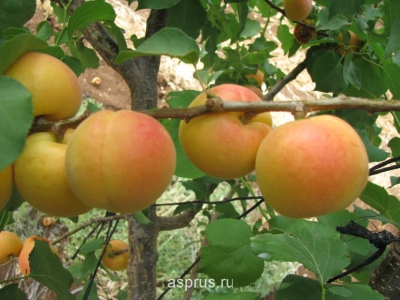
- Flowers: medium, pink
- Fruit weight, g: 50-80
- Fruit shape: rounded-oval, slightly compressed from the sides
- Skin : slightly pubescent
- Fruit color: yellow-orange, with a slight blush
- Pulp color : golden orange
- Pulp (consistency): tender, juicy
- Fruit taste: sweet and sour, good
- Tasting assessment: 4.25 points
- Bone size: small
Any gardener who wants to plant an apricot on his site seeks to choose a variety that is unpretentious in care and at the same time gives a bountiful harvest with excellent taste. Polessky large-fruited corresponds to the above parameters.
Description of the variety
The culture is vigorous, reaching a height of 4-5 m. The tree grows intensively in the first few years after planting. When the apricot begins to bear fruit, the growth rate slows down. The crown is very sprawling, with a strong thickening, round-elongated shape.
The leaves are large, ovoid in shape, with a slight sharpening at the tips. The leaf blade is thin and smooth, dark green in color. The flowers are medium in size, light pink. Fruit inflorescences are formed on the shoots of the previous year.
Among the advantages, gardeners distinguish:
- early fruiting;
- frost resistance (wood and reproductive buds are able to quickly recover from frostbite, even if frosts caught the tree during the flowering period);
- fruits do not crack;
- drought resistance;
- it is very rare for apricots to have a tolerance for stagnation of moisture on the surface of the earth;
- persistent immunity to most diseases.
There are few disadvantages, but they are:
- excessive formation of vertically growing shoots requiring regular pruning;
- a limited number of regions for cultivating the variety.
Fruit characteristics
The culture bears large fruits. On average, the weight of one fruit can be 50-80 g. Their shape is rounded-oval, slightly flattened on the sides. With excess moisture, the fruits do not crack. The skin is slightly drooping, yellow-orange color with a slight blush. The small bone separates well from the pulp. The core located inside has a sweet taste.
The harvested apricots show a good level of keeping quality and transportability. With proper storage, the fruits do not lose their marketable and appearance within 30 days.
Taste qualities
Juicy golden-orange pulp has a rich sweet and sour taste and a pleasant fruity aroma. The consistency of the pulp is tender. On a five-point tasting scale, the fruits are evaluated at 4.25 points.
Ripening and fruiting
During the fruiting period, the culture enters the 3rd year of development. By the time of fruiting, Polesskiy large-fruited is a variety of the late ripening period. Apricot blooms in late March - early April. They begin harvesting in late July - early August. Fruiting is annual.

Yield
Starting from 3 years of growth, the plant gives a small amount of harvest, but after a couple of years, 10-15 kg of fruit can be harvested from one tree.10-year-old specimens are on average capable of producing 110 kg.
Self-fertility and the need for pollinators
One of the features of the variety is partial self-fertility, so experienced gardeners recommend planting apricot varieties that bloom at the same time, which will double or even triple the yield. The following varieties are considered the most successful pollinators: Pineapple, Amur, Polesskiy yielding, Golden Jubilee, Khabarovskiy.
Growing and care
To get good yields every year, the apricot must be planted in the sunniest place. It is advisable to protect young seedlings from cold northerly winds. It is preferable to plant the crop in late autumn, a month before the onset of frost. During this time, the seedling will have time to take root.
The planting pit is prepared in advance, at least 2 weeks in advance. This is necessary so that during this time the necessary microflora is formed in the hole. Polesie large-fruited is not particularly picky about the composition of the soil. However, the culture grows well on light, loose and fertile substrates with a neutral pH level.
In fertile soils, a hole is dug with a size of 70x70. On heavy soils, the hole is made almost half the size. This is necessary in order to prepare the soil mixture and apply fertilizers. The acidity is lowered with lime, chalk or ordinary eggshells. Wood ash, peat, sphagnum cope with alkalinity.
To prepare the soil mixture, you need to use not all of the dug soil, but only the top layer. Mineral and organic fertilizers are also added. The first part of the substrate is placed in the hole with a slide, on which the seedling is placed, covered with the rest, thoroughly rammed and watered abundantly.
Further care of the culture does not have any particular difficulties. It is important to prune in time, as the plant sprouts many shoots, over-thickening the tree.
You need to feed the apricot carefully. The main thing is not to overdo it. Nitrogen is added in the spring, complex trace elements in the summer, and potassium, phosphorus, and calcium in the fall.



Disease and pest resistance
It is necessary to timely process the apricot from diseases and pests. However, the variety staunchly resists fruit rot, moniliosis and perforated spot.
































































